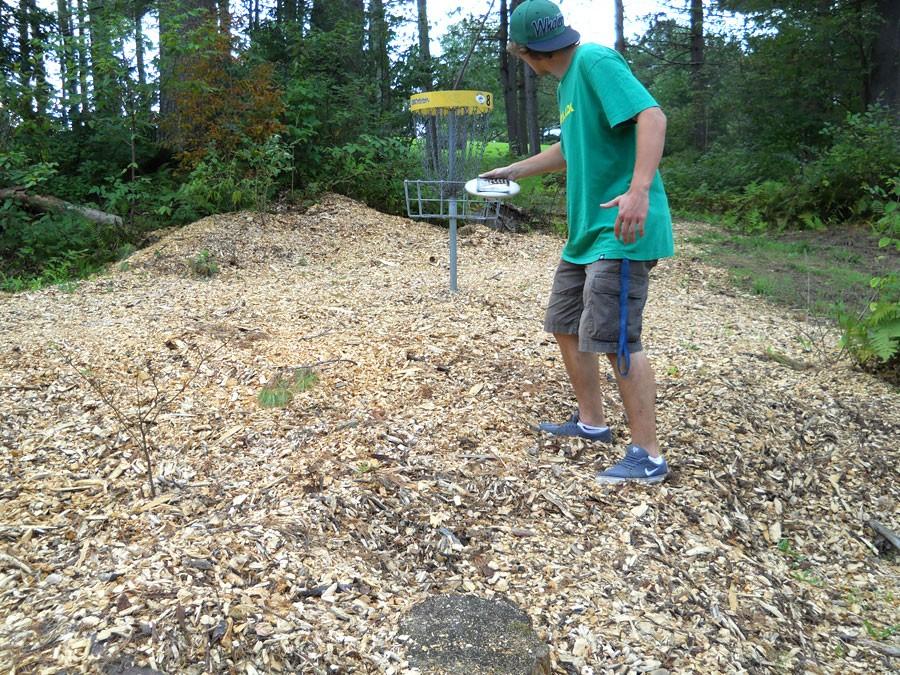Logging opens forest for next generation
Johnson State College logging operations continued this past summer where a few areas within the disc golf course were dry enough for harvesting.
Following last winter’s delay, operations followed near the disc golf course behind the Visual Arts Center, and soccer field after it became dry enough to work with. This ultimately led to the closure of that part of the course for the majority of the summer for safety reasons. Approximately 100 acres of land spread throughout the land owned by the school is ready to be logged. Operations started in November of 2014 with a bidding process that helped narrow down the hiring process for the job.
Throughout the whole logging process thus far, the main setback has been dealing with the weather. JSC Controller Toby Stewart has been working closely with the logging operations on campus since they started last November. “There was a fair amount of logging that was done this past winter,” said Stewart. “There is a lot more that will need to be done.” Stewart explained the knowledge that he had gained about projects like this from the Lamoille County Forester Ray Toolan who is overseeing the project.
“This sale is primarily a salvage operation where over-mature and high-risk stems are being harvested,” said Toolan. “In the process we are releasing existing regeneration and setting the stage for new regeneration.” This will allow for the younger growing trees to be in full sunlight, and they will be able to claim their space in the main canopy of the forest.
“Winter is the time of year that the majority of the logging will need to be done,” says Stewart. “It is the time of year when the ground can be frozen along with the trails to protect the surface of the ground from being altered.” Though this may be the case operations were still delayed this past winter due to the amount of moisture in the ground.
“The next area that operations will be taking place is area nine,” said Stewart, referring to the land behind the solar panels. “It is another unique area where the soil is dry enough for the majority of that area to be logged in the summer months,” says Stewart.
Once winter hits and the ground freezes, the next area of focus is the other area of the disc golf course that lines the ski and ride terrain park. Stewart mentioned that progress in the logging operation remains dependent upon the weather. “If it’s not cold enough for a long enough stretch of time operations will be slowed.” As far as the logger’s perspective goes, Stewart mentioned that he is hoping for another long cold winter for that reason.
Though the project may seem like a very long process at this point, Stewart made it clear that there are several benefits coming out of this project. “We are receiving payments each time lumber is delivered to mills,” said Stewart. “We also have never had a forest management project here at JSC.”
The college has gained about $9,000 at this point out of the project. Stewart mentioned that there are a lot of trees that are over mature. “When this happens they can become dangerous, and a safety issue,” said Stewart.
Toolan mentioned that the area’s being logged haven’t been managed since the early 1950’s. “Management is an ongoing process. After the sale is complete the college should conduct a forest inventory to determine exactly what the composition of the post-harvest forests are.” Once this information is in hand the college can then use it to plan future foresting activities on its land. “This information should then be put into a long term management plan document,” said Toolan.
Stewart explained that over mature trees lose their usefulness, and the lumber doesn’t always serve a good purpose for being used as lumber for building. Stewart noted that the benefits to the college of having selective cutting preformed go beyond the economic standpoint.
In addition to this taking out trees and possibly invasive species, sunlight will be more prominent in the forest which will bring growth for the next generation of trees. Thinning is essential for a healthy forest.
Toolan also made it clear that there are many invasive species of plants surround the college, and can cause harm to the base layer of the forest. “Honeysuckle, Barberry, Frag-mites and possibly Buckthorn are all present in the land,” said Toolan. “These exotic invasive species of plants can take over the habitats of native vegetation and upset the balance between plant and animal communities. JSC should have an aggressive program to remove these invasive species on an annual basis.” This will ultimately promote natural habit growth over the invasive species.
“Once work is done near the cross country trails on the other side of the snow park area, it will allow more sun to dry out the trails quicker,” said Stewart. Along with this, Stewart mentioned that the leftover brush will help create habitats for smaller animals, and wildlife in the woods.
Stewart explained that all together the number one challenge is weather. Following this is the market for lumber as it often fluctuates. “I was naively hoping for more progress by this point,” said Stewart. “This is mainly due to my inexperience with this type of operation.”
He says he will call it a success in a year or so if it’s done and over with. For right now, he described himself with being happy with the work that has happened already.



